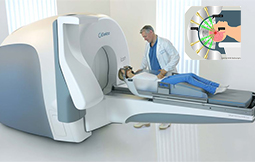
Gamma Knife surgery is a type of radiation therapy used to treat tumors, vascular malformations, and other abnormalities in the brain. Gamma Knife surgery, like other forms of stereotactic radiosurgery (SRS), is not surgery in the traditional sense because there is no incision. I
Gamma Knife surgery is a type of radiation therapy used to treat tumors, vascular malformations, and other abnormalities in the brain. Gamma Knife surgery, like other forms of stereotactic radiosurgery (SRS), is not surgery in the traditional sense because there is no incision. Instead, Gamma Knife surgery uses specialized equipment to focus on 200 tiny beams of radiation on a tumor or other target with submillimeter accuracy. Although every beam has very little effect on the brain tissue it passes through, a strong dose of radiation is delivered to the place where all the beams meet.
This type of radiation treatment is usually performed when:
Before the procedure begins, you’ll have a lightweight frame attached to your head with four pins. This frame will stabilize your head during the radiation treatment and serve as a point of reference for focusing the beams of radiation. During this process:
After the head frame is attached, you’ll undergo imaging scans of your brain that show the location of the tumor or other abnormality in relation to the head frame.
You’ll lie on a bed that slides into the Gamma Knife machine, and your head frame will be attached securely to a helmet inside the machine. You’ll have an intravenous (IV) tube that delivers fluids to your bloodstream to keep you hydrated during the day. A needle at the end of the IV is placed in a vein, most likely in your arm. The time needed to complete the procedure may range from less than an hour to about four hours, depending on the size and shape of the target. During the procedure:
After the procedure, you can expect the following:
Fatigue: Tiredness and fatigue may occur for the first few weeks after Gamma Knife surgery.
Swelling: Swelling in the brain at or near the treatment site can cause a variety of symptoms depending on what areas of the brain are involved.
Scalp and hair problems: Your scalp may be red, irritated, or sensitive at the four sites where the head frame was attached to your head during the treatment.
Copyright © 2025 IMA | All Rights Reserved.